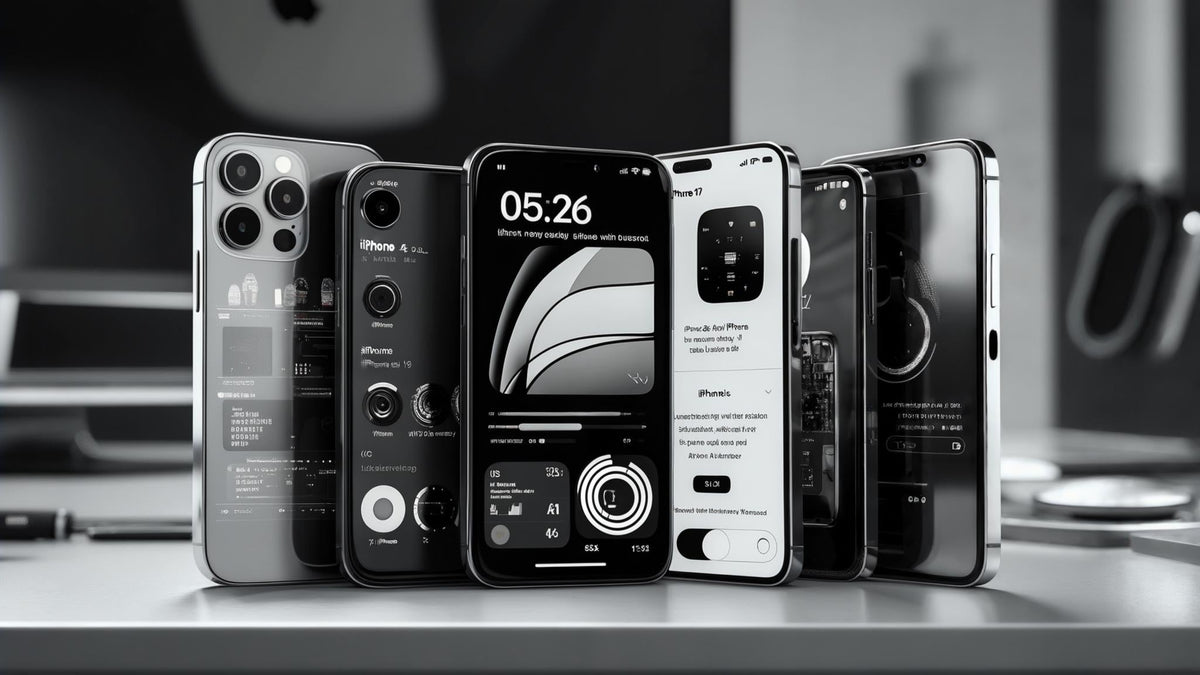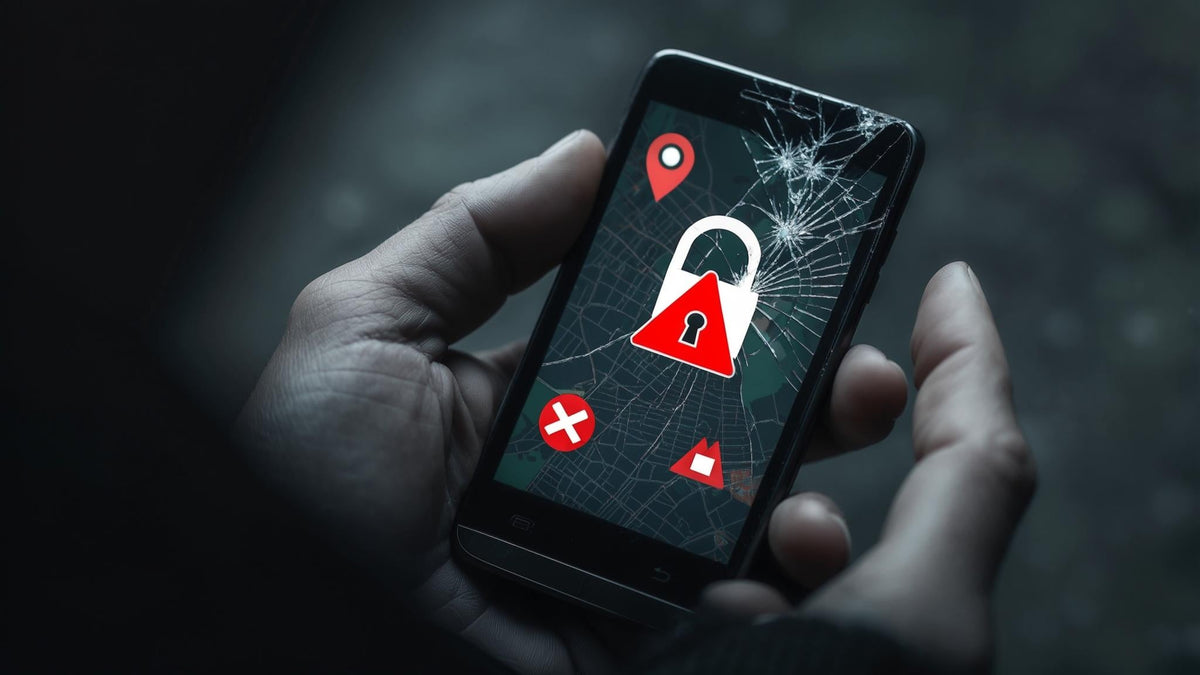Last summer, I watched my friend Jake fish his brand-new iPhone out of the pool. That sinking feeling in your stomach? We've all been there. The good news is that most water disasters are totally preventable - you just need to know what actually works (spoiler: those IP ratings aren't as bulletproof as you think).
Here's a wild stat that'll make you nervous about your next pool party: According to device insurance company Asurion, water-related damage claims spike by 54% on Independence Day alone compared to regular days. We get comfortable around pools, beaches, and boats, forgetting that even "waterproof" phones can fail when you least expect it.
This guide breaks down everything you need to know about keeping your phone dry. I'll cover why water is so dangerous to your device, how to choose the right protection, and what to do when disaster strikes anyway. Because trust me, even with the best preparation, accidents happen.
Table of Contents
Understanding Why Water Destroys Your Phone
Waterproof Pouches and Bags: Your Phone's Best Friend
Smart Prevention Tactics That Actually Work
Emergency Response When Water Wins
-
Professional-Grade Protection for Serious Users
TL;DR
IP ratings don't guarantee real-world water protection - even "waterproof" phones can fail
Waterproof pouches and bags offer the most reliable protection for any phone
Test your waterproof protection with tissue paper before trusting it with your device
If your phone gets wet, power it off immediately and resist the urge to check if it works
-
Professional-grade cases provide the foundation for serious water protection strategies
Understanding Why Water Destroys Your Phone
Your phone hates water more than you hate Monday mornings. Even those fancy "waterproof" phones with impressive ratings? They're not as tough as the marketing suggests.
Here's what actually happens: Water sneaks into tiny gaps, starts corroding delicate parts, and can either kill your phone instantly or play the long game - showing up as weird charging issues or muffled speakers weeks later. I've seen phones that seemed totally fine after a dunking suddenly start acting up days later.
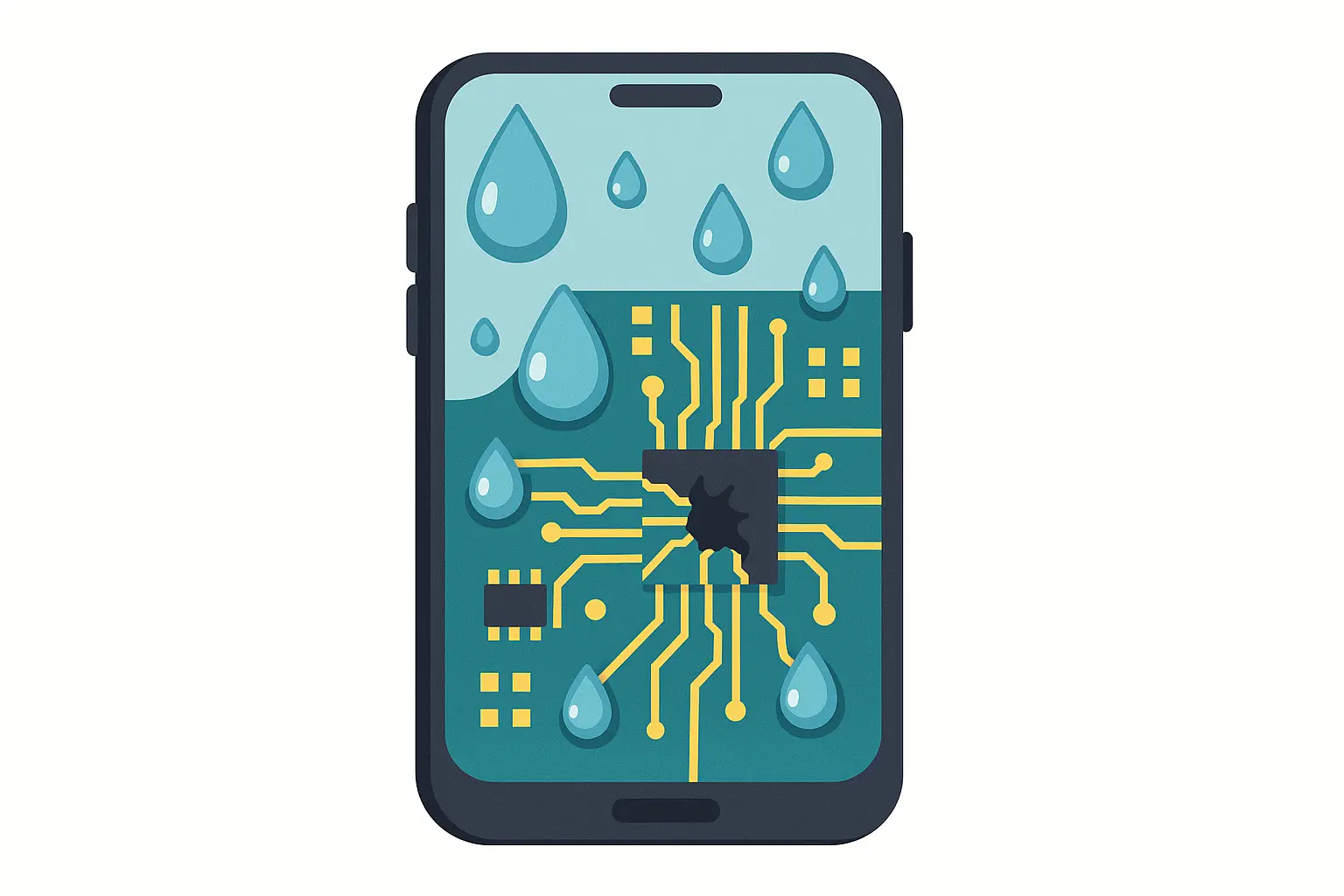
Why IP Ratings Are Basically Lies (Sort Of)
Those IP ratings you see advertised? They're tested in perfect lab conditions that have nothing to do with your actual life. The rating uses two numbers - first one is dust protection (0-6), second is water resistance (0-9).
But here's the problem: Lab tests don't account for your phone bouncing around in your pocket for six months, weakening those seals. They don't test with pool chemicals, salt water, or the pressure you get just three feet underwater.
When you're learning how to protect phone from water, you can't rely solely on manufacturer ratings - real-world conditions are way harsher than any lab test.
|
IP Rating |
Water Protection Level |
Real-World Meaning |
Limitations |
|---|---|---|---|
|
IPX4 |
Splash resistant |
Light rain, kitchen splashes |
No submersion protection |
|
IPX6 |
Water jet resistant |
Heavy rain, shower steam |
Pressure-sensitive |
|
IPX7 |
Temporary submersion |
Up to 1 meter for 30 minutes |
Fresh water only, room temperature |
|
IPX8 |
Extended submersion |
Beyond 1 meter, manufacturer specified |
Varies by device, degrades over time |
Real Talk on Common Ratings:
IPX4: Can handle rain, kitchen splashes (no dunking allowed)
IPX7: Survives brief dunks up to 3 feet (fresh water only, don't push it)
IPX8: Supposedly handles deeper water longer (but "longer" varies wildly by manufacturer)
The Pelican Marine cases I recommend actually outperform most phone ratings - they'll stay bone dry at 3 feet deep for a full hour.
Real-World Failure Points
Laboratory testing can't replicate every scenario your phone might face. Pool pressure at just 3 feet deep exceeds many IP68 specifications. Temperature changes cause materials to expand and contract, creating gaps where none existed before. I've personally seen "waterproof" phones fail in shallow pools because the manufacturer's testing didn't account for the specific conditions that day.
Saltwater corrodes faster than fresh water, hot tub chemicals attack rubber seals, and even a small drop can compromise the precise tolerances that keep water out.
How Your Phone Actually Gets Wet (It's Usually Dumb)
Forget dramatic ocean rescues - most phones die boring deaths. Toilet drops are the #1 killer, followed by kitchen sink mishaps and drink spills. Pool incidents make better stories, but bathroom accidents are the real phone killers.
Then there's the sneaky stuff: shower steam creeping into cases, morning dew in your pocket during a jog, or just high humidity on a hot day. My friend Sarah learned this the hard way when her iPhone started acting weird after a beach day - turns out the combination of heat, humidity, and wet towels in her bag created enough moisture to mess up her speakers.
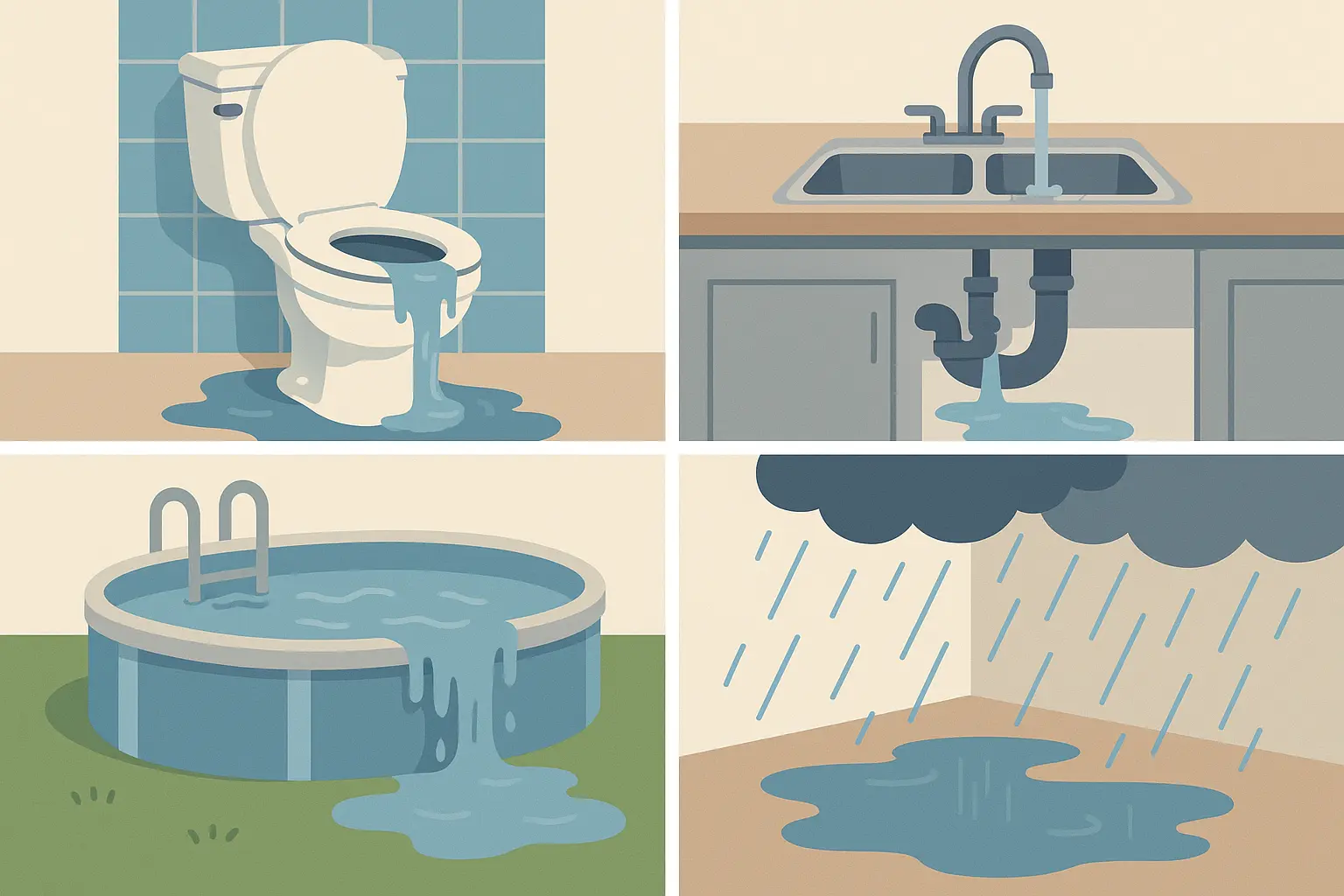
Sneaky Environmental Threats
Rain damage often occurs gradually, with moisture seeping through compromised seals over multiple exposures. Recent reports show that Fourth of July celebrations present the highest risk for phone damage all year, with water-related incidents, cracked screens, and lost devices all spiking significantly during holiday water activities.
Humidity, condensation, and temperature changes create water damage without obvious exposure events. Steam from hot showers can penetrate phone cases, morning dew accumulates in pockets during outdoor activities, and rapid temperature changes cause condensation inside sealed devices.
Spotting Water Damage Before It's Too Late
Early detection can mean the difference between a quick fix and a total loss. Water damage symptoms often appear gradually, starting with minor performance issues that escalate to complete failure if ignored.
Watch Out For:
Screen fogging (dead giveaway)
Charging port looking corroded or discolored
Audio sounding muffled or distorted
Random shutdowns or charging problems
Touch screen acting possessed
Camera lenses fogging up from the inside
-
Battery life suddenly tanking
Water Damage Detection Checklist:
Check for screen fogging or condensation under glass
Inspect charging port for corrosion or discoloration
Test speaker and microphone clarity
Monitor battery life for sudden degradation
Look for phantom touches or dead screen zones
Check camera lenses for internal condensation
-
Examine water damage indicators if accessible
Waterproof Pouches and Bags: Your Phone's Bodyguard
Forget trusting your phone's built-in protection - get a proper waterproof pouch. These things work with any phone and actually keep water out when it matters. I consider them essential for water activities, outdoor adventures, or just peace of mind during daily activities.
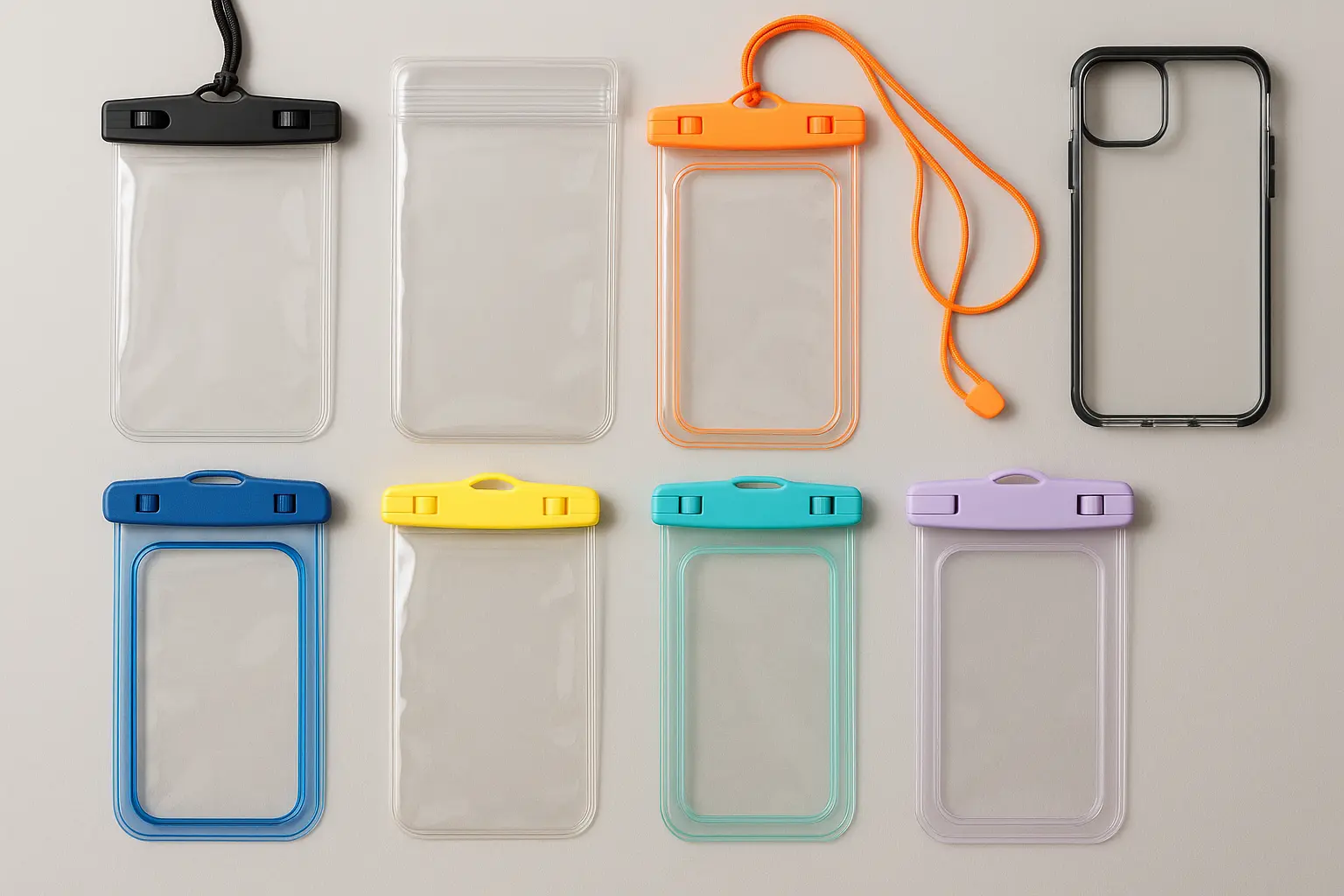
What Actually Works
Different waterproof solutions serve different needs, from basic splash protection during light rain to full submersion protection for water sports. Understanding what works best helps you choose protection that matches your specific risk profile.
Clear Plastic Pouches for Everyday Use
These are your best bet for most situations. Under $10, fits in your pocket, lets you use your phone normally, and actually works. Perfect for beach days or pool parties.
Flexible, transparent pouches with roll-top or zip-lock seals offer the perfect balance of protection and usability. These maintain full touchscreen functionality, allow clear photos and videos, and fit easily in pockets or bags. Budget-friendly options can cost under $10 for a two-pack with cases and lanyards, making them accessible protection for any phone user.
Hard Cases for Extreme Conditions
These are overkill unless you're doing serious water sports. They're bulky and expensive, but if you're scuba diving with your phone (why?), this is what you need.
Rigid waterproof cases with O-ring seals provide maximum protection for serious water activities. These cases can handle significant pressure and extended submersion but add considerable bulk and may require special adapters for charging or audio connections.
Waterproof Bags with Extra Storage
Great when you need to protect your phone plus other stuff - chargers, earbuds, cash. Perfect for boat trips or camping.
Larger waterproof bags accommodate phones with bulky cases while providing space for accessories. These bags often include lanyards or attachment points for securing to boats, backpacks, or life jackets. A quality waterproof phone bag can protect your device plus chargers, earbuds, and cash all in one sealed package.
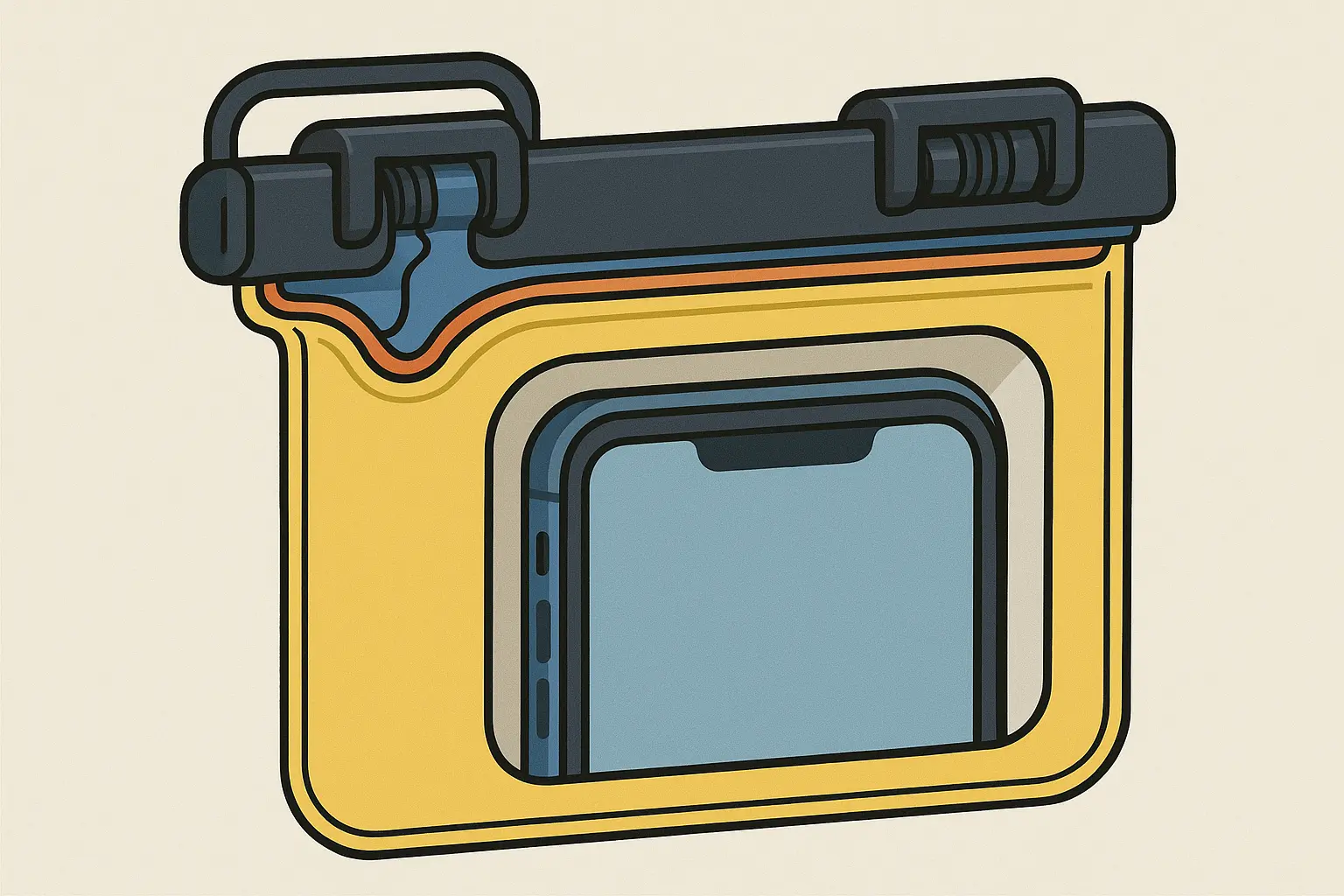
Choosing and Testing Your Waterproof Protection
Selecting the right protection requires careful consideration of your phone's dimensions, your intended activities, and the level of protection you need. More importantly, proper testing before use ensures your protection will work when you need it most.
Getting the Right Fit
Measure your phone with its case attached to ensure proper fit within the waterproof enclosure. Too tight, and you risk compromising the seal; too loose, and water can pool around your device.
Most pouches accommodate phones up to 6.7 inches, but always check dimensions rather than assuming compatibility based on phone model names.
|
Phone Size |
Recommended Pouch Dimensions |
Activity Compatibility |
Touch Sensitivity |
|---|---|---|---|
Up to 6.1" |
7.5" x 4" |
Pool, beach, light rain |
Excellent |
6.1" - 6.7" |
8.5" x 4.5" |
Swimming, snorkeling |
Good |
6.7"+ |
9" x 5" |
All water activities |
Moderate |
|
With bulky case |
10" x 6" |
Extreme conditions |
Limited |
The Tissue Test That'll Save Your Butt
Never trust any waterproof protection without testing it first. Stick a few tissues inside, seal it up, dunk it underwater for 5 minutes. Pull it out - if those tissues are even slightly damp, that pouch would've killed your phone.
My buddy Mike skipped this test and trusted Amazon reviews. His "5-star rated" pouch had a manufacturing defect that soaked his $1,200 iPhone on the first beach trip. Thirty seconds of testing would've saved him twelve hundred bucks.
This simple test costs pennies but could save you hundreds in replacement costs. Place a piece of tissue paper inside the sealed pouch or case, then submerge it completely for several minutes. Remove it and check for any moisture on the tissue - even slight dampness means the seal has failed and your phone would be at risk.
Waterproof Protection Testing Protocol:
Fold 2-3 tissues and place inside sealed pouch
Submerge completely in water for 5 minutes
Remove with completely dry hands
Open pouch and inspect tissues for any moisture
Test at different depths if planning submersion use
Repeat test after extended storage or travel
-
Replace protection if any dampness is detected
Smart Prevention (AKA Don't Be Stupid)
The best water damage is the kind that never happens. Most of this is just paying attention and not being careless. These strategies work alongside waterproof protection to create multiple layers of defense.
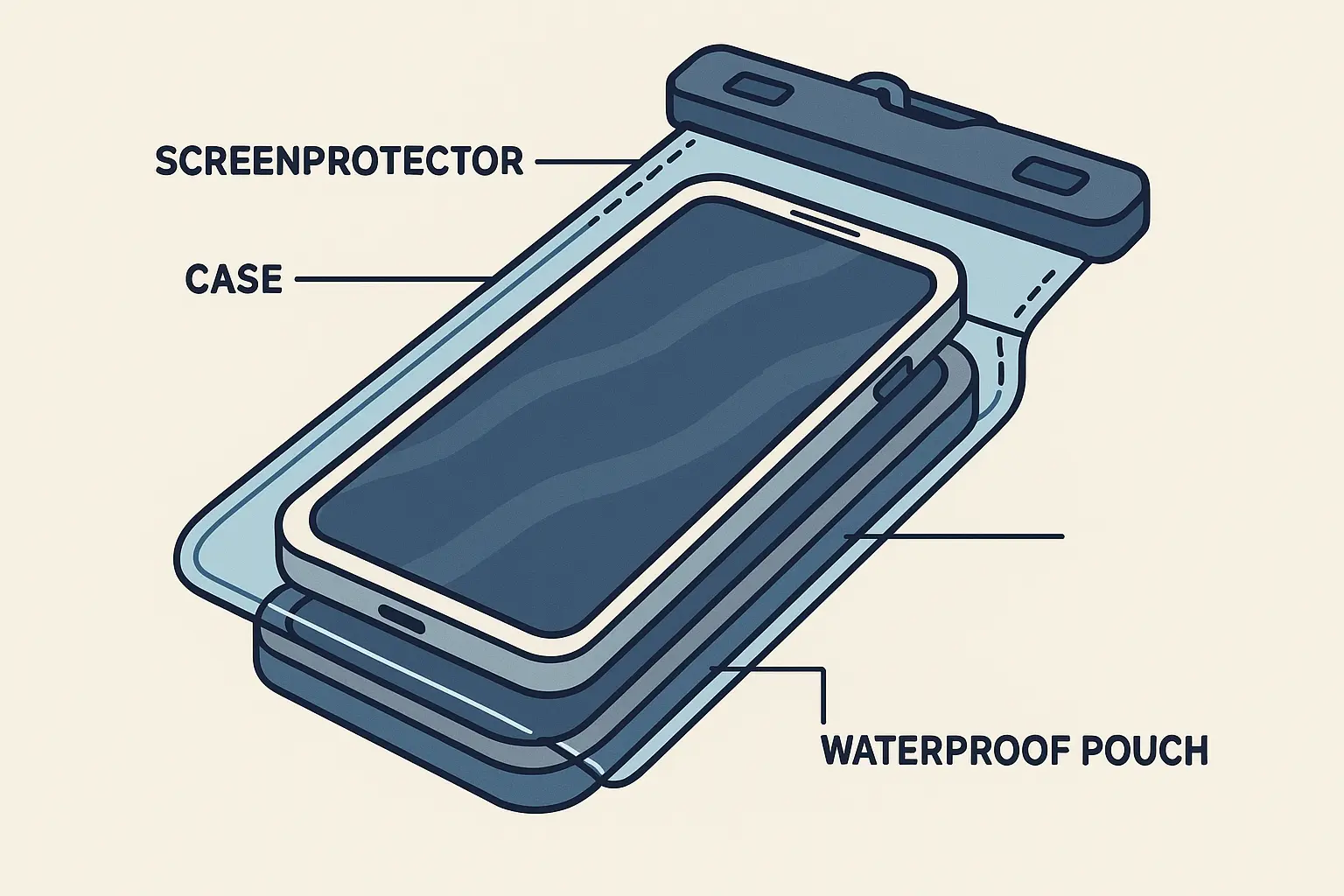
Building Water Awareness Into Your Daily Routine
Most water damage occurs during routine activities when people aren't thinking about risks. Building awareness of water hazards into your daily habits helps you recognize dangerous situations before they become expensive problems.
Environmental Risk Assessment
Check the Weather: Not just for your outfit, but for your phone. Rain means pouch time, period. Weather apps aren't just for planning outfits - they're essential tools for phone protection. Check conditions before heading out and prepare appropriate protection for rain, snow, or high humidity.
Avoid using your phone during storms, and be extra cautious around pools, hot tubs, or any body of water, even if you're not planning to get wet. Travel experts recommend investing in waterproof protection for summer activities, with tested options available for under $50 that provide reliable protection for beach trips, cruises, and rainy day hikes.
Create Phone-Safe Zones
Keep it away from bathroom counters, establish a charging spot away from the kitchen sink, and put it somewhere safe before any water activity. I keep a basket by my door specifically for when I'm doing dishes - saved me multiple times.
These simple boundaries prevent most accidental exposure incidents. Designate specific areas where your phone stays dry and secure, create a habit of securing your phone before any water-related activity, and establish a charging station away from kitchen sinks.
Layered Protection Strategies
Layer Your Protection: Good case + screen protector + waterproof pouch when needed = basically bulletproof protection.
Combining multiple protection methods creates redundancy that keeps your phone safe even when individual protections fail. Quality cases, screen protectors, and proper port maintenance provide the foundation for water resistance, while waterproof pouches add the final layer of security for high-risk situations.
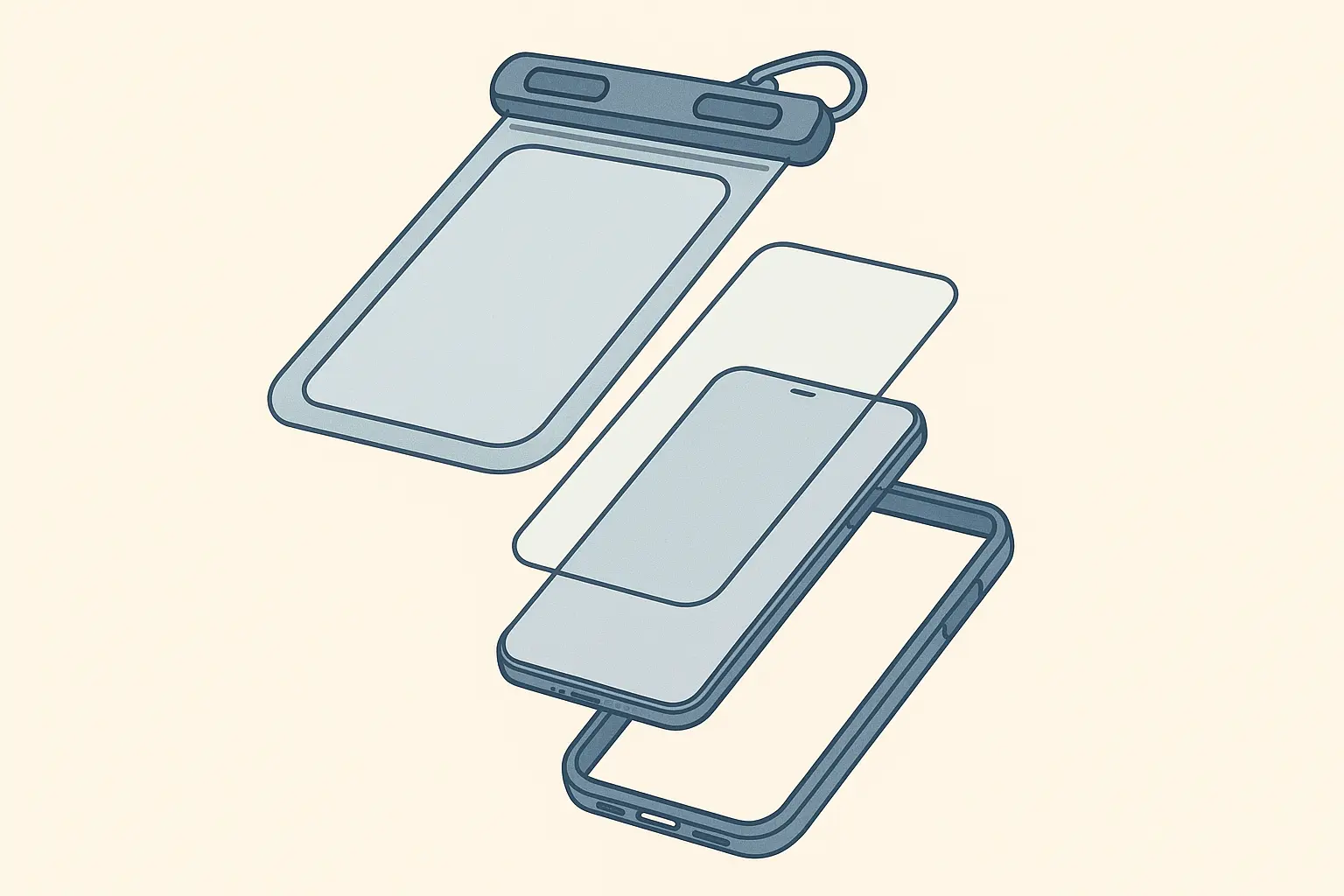
Case and Screen Protector Fundamentals
A quality case with raised edges around the screen and camera provides the first line of defense against water infiltration. Tempered glass screen protectors seal the display surface and prevent water from entering through micro-cracks.
Together, they create a barrier that gives you precious seconds to react when water exposure occurs.
Port Protection Protocols
Charging ports are the most vulnerable entry points for water damage. Keep them clean and dry, use port covers when available, and avoid exposing your phone to moisture immediately after charging when ports may still be warm and expanded.
Wireless charging eliminates port exposure entirely and should be your preferred method in humid environments. Jennifer developed a simple routine for beach days: phone goes into a waterproof pouch before leaving the car, stays there until she's completely dry and away from water, and gets wiped down with a microfiber cloth before being removed from protection. This simple protocol has kept her phone safe through three years of regular beach visits, while friends who skip these steps have replaced multiple devices.
When Water Wins: Emergency Mode
Crap happens. When it does, the next 30 seconds determine whether your phone lives or dies. Quick, appropriate action in the first few minutes after water contact can mean the difference between a minor scare and a major loss.
The key is fighting your natural instincts to check if the phone still works and instead focusing on preventing further damage while maximizing recovery chances.
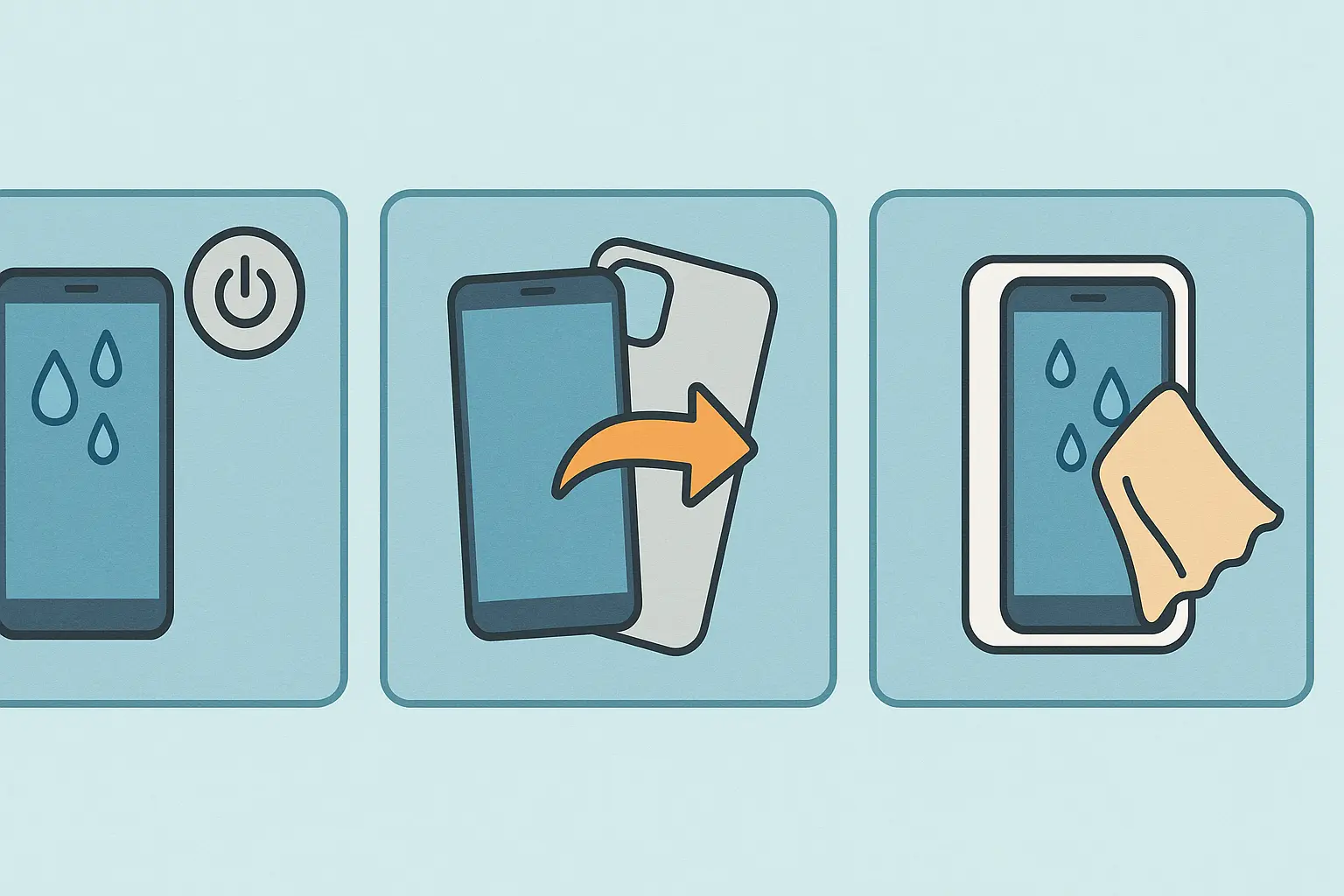
Critical First 30 Seconds
The actions you take immediately after water exposure determine your phone's survival chances. Every second counts, and the wrong move can turn a recoverable situation into permanent damage.
DO THIS RIGHT NOW:
Power Down Immediately - Don't test if it works, just turn it off. Turn off your phone the instant it contacts water, even if it seems to be working normally. Water and electricity create corrosion that can destroy components even when the phone appears functional.
If the screen is unresponsive, hold the power button until the device shuts down completely. Don't attempt to charge it or connect any accessories.
Remove and Shake (Gently) - Let it breathe. Take off any case or screen protector to allow better air circulation and prevent water from being trapped against the device. Gently shake the phone to remove excess water from ports and speakers, but avoid vigorous shaking that could drive water deeper into internal components.
Pat dry - Soft cloth, external surfaces only. Pat dry with a soft cloth, focusing on external surfaces only.
DON'T BE TEMPTED TO:
Use a hair dryer (you'll cook it)
Try charging it (you'll fry it)
Keep pressing buttons to "test" it (you'll push water deeper)
Emergency Water Exposure Response Checklist:
Power off device immediately (don't test if it works)
Remove case, screen protector, and any accessories
Gently shake to remove excess water from ports
Pat dry with soft, lint-free cloth
Do NOT use heat sources (hair dryer, oven, etc.)
Do NOT attempt to charge or connect cables
-
Do NOT press buttons repeatedly to test function
The Drying Game
Rice works, but silica gel packets work better. Toss your phone in a container with a bunch of those little packets you get in shoe boxes. Wait 24-48 hours minimum - I know it sucks, but patience saves phones.
Proper drying requires patience and the right materials to absorb moisture without causing additional damage. The goal is creating an environment that draws water out of internal components while preventing corrosion from progressing.
This process can't be rushed, and attempting to power on too early often causes permanent damage to phones that could have been saved. I keep a small container with silica gel packets specifically for emergencies - it's saved two phones over the years.
When to Seek Professional Help
If it still won't turn on after proper drying, take it to a repair shop. Sometimes they can work magic, but don't spend more fixing it than buying a new one.
If your phone doesn't respond after proper drying, or if you notice corrosion around ports and buttons, professional repair services may be able to save it. They have specialized equipment for removing moisture and cleaning corrosion that isn't available to consumers.
However, weigh repair costs against replacement value - sometimes letting go is the most economical choice.
Professional-Grade Stuff (For When You're Serious)
Most people don't need military-grade protection, but if you're in construction, first responder work, or just really hard on gear, these solutions are worth considering. When standard protection isn't enough, professional-grade solutions provide military-level water resistance for demanding environments.
These systems are designed for users who can't afford failure - first responders, military personnel, and outdoor professionals who depend on their devices in extreme conditions. While overkill for casual use, they represent the pinnacle of phone protection technology.
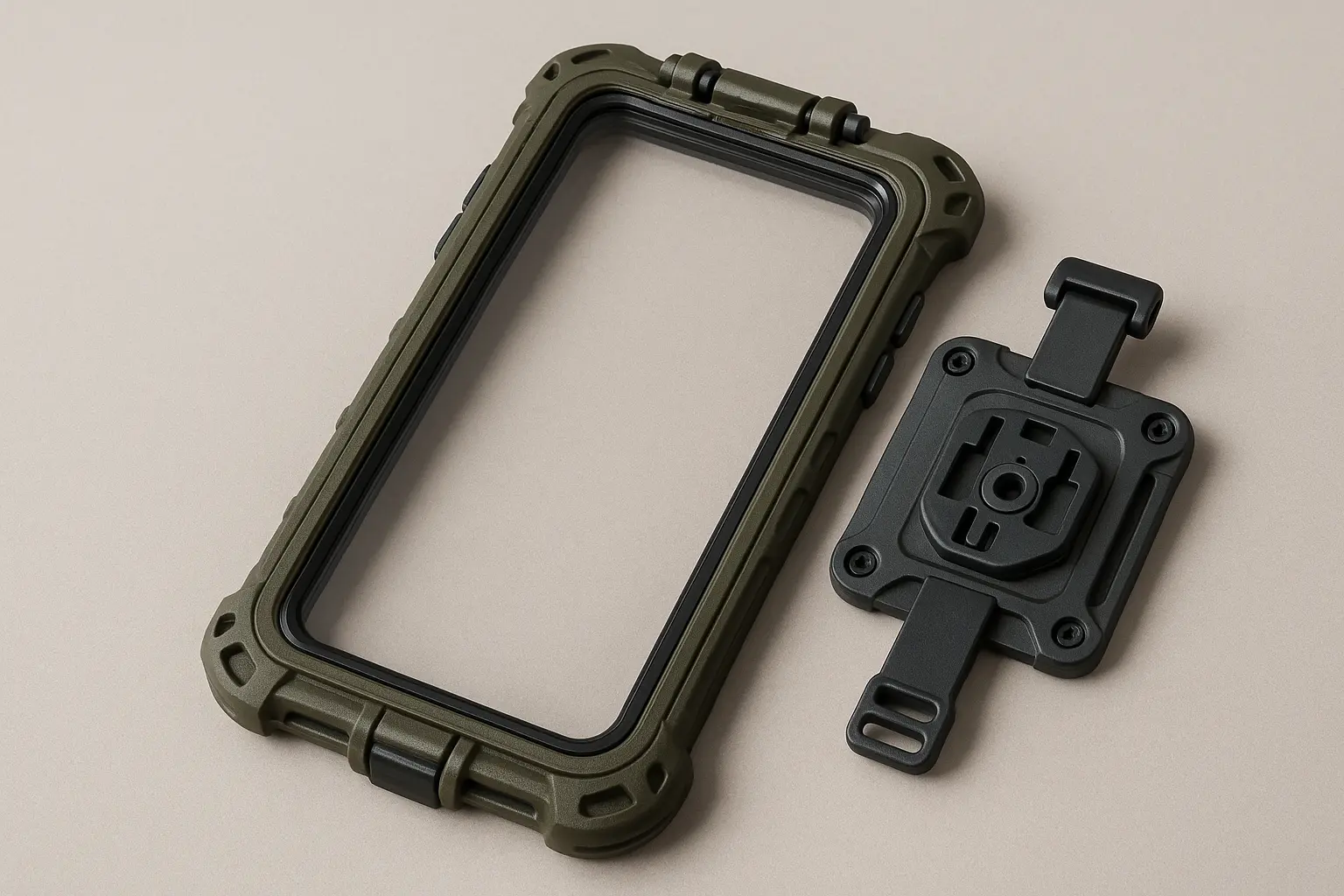
Military-Spec and Industrial Solutions
MIL-STD cases are tested way beyond normal consumer stuff - think extreme temperatures, salt spray, and pressure that would crush regular cases. Military specification cases undergo rigorous testing that far exceeds consumer-grade protection standards.
These cases are designed to protect critical communication equipment in combat and industrial environments where device failure can have serious consequences. The protection comes with trade-offs in size, weight, and cost, but the reliability is unmatched.
Understanding MIL-STD Testing
MIL-STD-810 testing subjects cases to extreme temperature variations, humidity, vibration, and impact scenarios that simulate real-world military conditions. Water resistance testing includes submersion under pressure, exposure to salt spray, and temperature cycling that causes seals to expand and contract repeatedly.
Cases that pass these tests offer protection levels that consumer IP ratings can't match.
Modular Protection Systems
Advanced protection systems allow users to add or remove protection elements based on specific mission requirements. Base cases provide everyday protection, while additional modules add waterproofing, shock absorption, or specialized mounting options.
This flexibility optimizes protection for each situation without carrying unnecessary bulk during routine use.
How Rokform Fits In
Rokform cases aren't waterproof by themselves, but they're perfect foundation pieces. Their military-grade construction means they won't crack and compromise your waterproof pouch's seal. Plus, their mounting systems work great even when your phone's in a waterproof case - perfect for motorcycle rides in unpredictable weather.
While Rokform cases excel at drop protection and secure mounting, they provide an excellent foundation for comprehensive water protection strategies. Their military-grade construction and innovative mounting systems work seamlessly with waterproof pouches and bags, creating a complete protection ecosystem for active users who need both durability and functionality.
Building on Rokform's Protective Foundation
Rokform's polycarbonate construction and 6-foot drop rating create a solid base layer that protects against impacts that could compromise waterproof seals. When combined with waterproof pouches, this dual-layer approach provides protection against both physical damage and water infiltration.
The precise fit and quality construction ensure that additional protection layers seal properly.
Mounting Solutions for Water Activities
Rokform's RokLock™ and MAGMAX™ mounting systems allow secure phone attachment even when using waterproof protection. Whether you're mounting to a boat dashboard, motorcycle handlebars, or bike frame, these systems keep your protected phone accessible and secure during water activities.
For motorcycle enthusiasts who need reliable water protection while riding, Rokform's motorcycle phone mounts work perfectly with waterproof pouches to keep devices accessible yet protected during unexpected weather. The quick-release mechanisms work through most waterproof pouches, maintaining functionality without compromising protection.
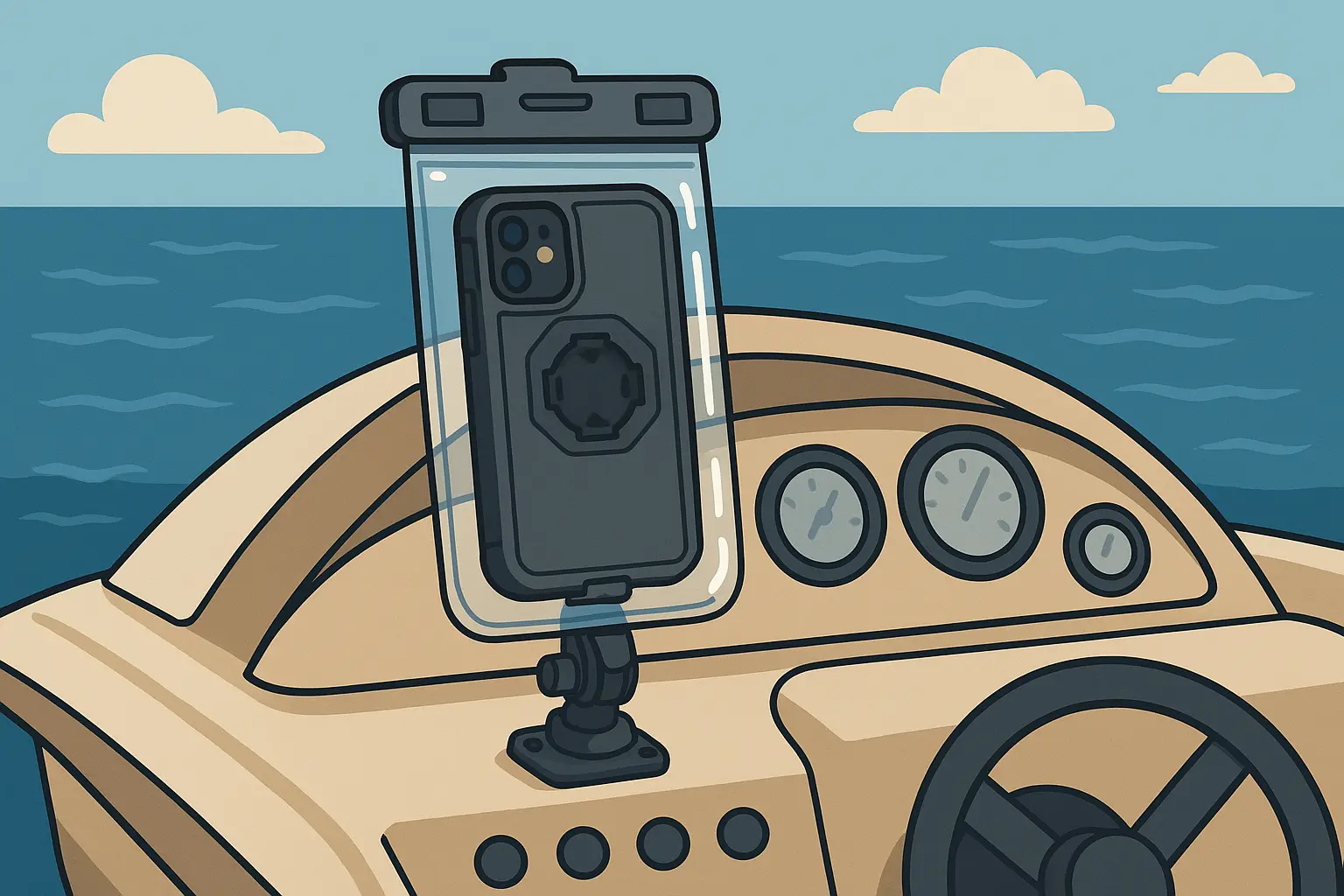
Ready to protect your phone like a pro? Rokform's military-grade cases provide the foundation you need for serious water protection. Check out our complete lineup of protective cases and mounting solutions designed for users who demand reliability in any environment.
Bottom Line
Water damage sucks, but it's preventable. Get a decent waterproof pouch, test it before you need it, and don't be an idiot around water. Your phone's too expensive and too important to gamble with.
The few bucks you spend on protection beats the hundreds you'll spend replacing a drowned phone. With the right knowledge, protection, and response strategies, you can keep your phone safe in virtually any environment.
The key is layering multiple protection methods, testing your gear before you need it, and developing habits that prevent exposure in the first place. Whether you choose simple waterproof pouches for occasional protection or invest in professional-grade systems for extreme conditions, the cost of prevention is always less than the price of replacement.
Your phone is too important to your daily life to leave its survival to chance - take action now, before you need it.








